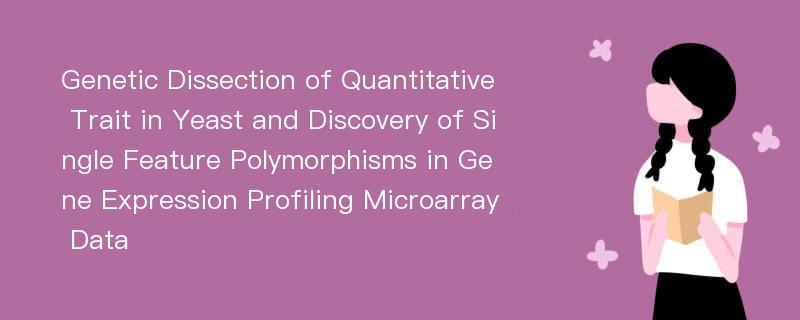
论文摘要
鉴定控制和影响复杂性状的功能基因是当前遗传学中最具挑战性的领域之一。遗传作图的终极目标是检测和定位产生性状差异的遗传变异,在这个过程中最根本的困难来自于基因定位方法粗糙的解析率。传统的的分析手段通过初始的基因组扫描获得的最小的数量性状位点(QTL)区间都不小于10~30 cM,这样大的一个遗传距离并不适合从分子水平上解析复杂性状的遗传变异。本论文主要包括两个方面的内容,一是数量性状的遗传剖析,另一个是利用基因芯片数据检测遗传多态。第一部分内容以酿酒酵母(Saccharomyces cerevisiae)的乙醇耐受这一复杂性状作为一个遗传模型,试图高精度高解析率地解析复杂性状的多基因遗传结构。我们选择了两个表型差异极其显著的酵母菌株,同时开发了一套在全基因均匀分布的STR/SNP遗传标记。选择的两个酵母菌株杂交后生成传统的F2群体并随后建立了多世代的双向重复选择回交(recurrent selection and backcross,RSB)群体。在F2分离群体用复合区间作图(CIM)方法,定位了5个QTL,它们共同解释了约50%的表型变异;其中第九号染色体上的主效QTL解释了25%的表型变异。RSB作图方法充分利用了一套高密度标记信息,定位到了更多的QTL,QTL区间也进一步缩小,在9号染色体的一个QTL区间已经缩小至仅仅包括少数几个基因,已经能够通过对极少的几个基因进行敲除和替换实验来确认影响乙醇耐性的功能基因。在全基因组范围检测基因编码区的序列多态具有重要的价值,一是有助于了解基因的功能,二是能获得高密度的遗传标记可以用于QTL作图。本论文第二部分的内容提出了一个新的算法,该算法利用基因芯片表达谱数据来检测序列多态。这种在基因芯片上检测的多态已经被命名为单征多态(single feature polymorphism,SFP)。SFP可以用作遗传标记来对杂交群体进行基因分型。与文献报道的4种方法相比较,这种新的SFP算法(1)受基因表达量差异的影响小,(2)RNA表达谱芯片与基因组DNA杂交芯片有近似的检测和基因分型的效力,(3)有较高的交互预测能力,以及(4)较高的假阴性率和较低的假阳性率。我们分别用SFP分型数据和SNP分型数据对一个barley单倍体二倍化(double haploid,DH)群体构建遗传连锁图,发现SFP分型数据构建的连锁图有相当的可靠性。这种SFP检测方法应用于前述的酵母RSB群体,有效地提高了QTL作图的解析率。
论文目录
AcknowledgementsLIST OF FIGURESLIST OF TABLESABSTRACT摘要PART ⅠCHAPTER 1.INTRODUCTION1.1.Genetic Basis of Phenotype Variation1.2.Identifying Genes Affecting Quantitative Traits1.2.1.Mutagenesis1.2.2.QTL Mapping1.2.2.1.Basis Concepts of QTL mapping1.2.2.2.Molecular Markers1.2.2.3.High Resolution Mapping1.2.2.4.From QTL to Gene1.2.3.Genetical Genomics1.3.Ethanol Tolerance in the Budding Yeast Saccharomyces cerevisiae1.3.1.Yeast as a model organism1.3.2.Ethanol tolerance in yeast1.3.2.1.Ethanol Fermentation with Yeast1.3.2.2.Biochemical/Physiological Determinants of Ethanol Tolerance in Yeast1.3.2.3.Progress in Genetic Dissection of Ethanol Tolerance in Yeast1.4.ObjectiveCHAPTER 2.SELECTION OF HIGHLY PHENOTYPICALLY DIVERGENT STRAINS2.1.Reagents and Solutions2.1.1.Reagents2.1.2.Solutions2.2.Materials2.2.1.Strains2.2.2.Plasmids2.3.Methods2.3.1.Phenotype Scoring of Ethanol Tolerance2.3.2.Preparation of Competent Cells2.3.3.Bacteria Transformation2.3.4.Plasmid Extraction2.3.5.Yeast Transformation2.3.6.Yeast DNA Extraction2.3.7.Yeast Tetrad Spores Dissection2.3.8.HO Gene Knockout2.3.9.Diploidization and Mating-type Switch2.3.10.Selection of Parent Strains with Divergent Ethanol Tolerance Phenotype2.3.11.Gene Dosage Assay2.4.Results2.4.1.Phenotype Distribution in 53 Yeast Strains2.4.2.Selection for Parent Strain with Low Ethanol Tolerance2.4.3.Performance of Haploid and Diploid Strains2.5.Discussion2 POPULATION'>CHAPTER 3.GENOMEWIDE SCANNING FOR ET QTL AND CANDIDATE QTL GENES IN F2POPULATION3.1.Reagents and Materials3.1.1.Reagents3.1.2.Materials3.2.Methods2 Mapping Population'>3.2.1.Establishment of F2 Mapping Population3.2.2.Screening of Short Tandem Repeat Markers3.2.3.Screening of SNP Markers3.2.4.Genotyping3.2.5.DNA Gel Extraction3.2.6.PCR Purification3.2.7.DNA Sequencing3.2.8.Mapping Ethanol-tolerance QTL3.3.Results2 Mapping Population'>3.3.1.F2 Mapping Population3.3.2.Molecular Marker3.3.3.Genomewide Scanning for ET QTL and Candidate QTL Genes3.3.4.Multi-locus Association Analysis3.4.DiscussionCHAPTER 4.FINE MAPPING USING RECURRENT SELECTION AND BACKCROSS BREEDING SCHEME4.1.Background4.2.Theoretical Basis of RSB4.3.Materials4.4.Methods4.4.1.Construction of Parent Strains with Opposite Mating Types4.4.2.RSB Breeding Scheme4.4.3.Genotyping of RSB Individuals4.4.4.Test for Maker-ET Association in RSB Mapping Population4.5.Results4.5.1.Construction of RSB Populations4.5.1.1.Selection of Highly Tolerant Segregants4.5.1.2.Selection of Sensitive Segregants4.5.1.3.Introgression of Donor Genes at Two STR Loci4.5.2.Marker-ET Association4.5.3.Fine Mapping on Chromosome 9 and Functional Evaluation of the Candidate Gene4.6.DiscussionBIBLIOGRAPHYPART ⅡCHAPTER 5.INTRODUCTION5.1.Backgronud5.2.DNA Microarray5.3.Allelic Variation Scanning Using DNA Microarray5.4.Simultaneous Genotyping and Gene Expression Measurement5.5.ObjectiveCHAPTER 6.YEAST AND BARLEY MICROARRAY DATA6.1.Materials and Datasets6.1.1.Yeast Strains and RSB Mapping Population6.1.2.Yeast Genomic DNA Hybridizaiton and RNA Profiling Microarray Data6.1.3.Barley Expression Profiling Microarray Data6.1.4.Sources of Check Data6.2.Experiment Protocols for Yeast Genome 2.0 Arrays6.2.1.Reagents6.2.2.Labeled Genomic DNA Preparation6.2.2.1.Preparation of Yeast Cells for DNA Extraction6.2.2.2.Isolation of DNA from Yeast6.2.2.3.Determination of Yield and Purity of the DNA6.2.2.4.Genomic DNA Fragmentation6.2.2.5.Terminal Labeling and Checking of Labeling Efficiency6.2.2.6.Quantifying Labeled DNA6.2.3.RNA Target Preparation6.2.3.1.Preparation of Yeast Cells for RNA Extraction6.2.3.2.Hot Phenol Extraction of RNA from Yeast6.2.3.3.Purification of Total RNA from Yeast6.2.3.4.Preparation of Poly-A RNA Controls for One-Cycle cDNA Synthesis6.2.3.5.First-Strand cDNA Synthesis6.2.3.6.Second-Strand cDNA Synthesis6.2.3.7.Cleanup of Double-Stranded cDNA6.2.3.8.Synthesis of Biotin-Labeled cRNA6.2.3.9.Cleanup of Biotin-Labeled cRNA6.2.3.10.Quantification of Biotin-Labeled cRNA6.2.3.11.Fragmenting the cRNA for Target Preparation6.2.4.Microarray Hybridization6.2.5.Washing,Staining,and ScanningCHAPTER 7.STATISTICAL INFERENCE OF SINGLE FEATURE POLYMORPHISMS7.1 Analytical Model7.2.SFP Genotyping7.3.Calculation of True Discovery Rate and Rate of False Negative7.4.Results7.4.1.Predictability of PM Hybridization Intensity7.4.2.Consistency in SFPs Predicted from Parallel DNA and RNA Datasets7.4.3.Proportion of Differentially Expressed Genes7.4.4.Mutual Predictability among Different Methods7.4.5.Efficiency to Predict Sequence Polymorphisms7.4.6.Genotyping and Genetic Map Construction Using SFPCHAPTER 8.DISCUSSIONBIBLIOGRAPHYLIST OF PUBLICATIONS
相关论文文献
标签:复杂性状论文; 乙醇耐受论文; 基因芯片论文;
Genetic Dissection of Quantitative Trait in Yeast and Discovery of Single Feature Polymorphisms in Gene Expression Profiling Microarray Data
下载Doc文档
